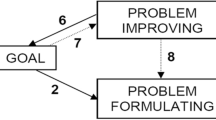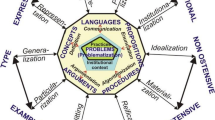Abstract
The goal of this chapter is to outline an approach for developing teachers’ proficiency in posing problems. Reasons why it is important for a mathematics teacher to be good problem poser are investigated. Links between knowing mathematics and knowing how to pose problems are also discussed. Training students in problem-solving techniques does not necessarily end in their learning mathematics. In this chapter, problem-posing activities based on the idea of transformation are described—two kinds of transformations are proposed and analyzed successively. The first is transforming problems from routine to advanced ones by changing elements in the problem space. The second is posing problems by transformation of representation. Developing problem-posing skills, from posing routine tasks to posing more complex mathematics problems, encourages student–teachers to think about problem posing as a creative professional activity. Lastly, the possibility to developing pupils’ capacity to pose problems via transformation is presented.
Access this chapter
Tax calculation will be finalised at checkout
Purchases are for personal use only
Similar content being viewed by others
References
Arcavi, A. (2003). The role of visual representations in the learning of mathematics. Educational Studies in Mathematics, 52, 215–241.
Ball, D. L. (1990). The mathematical understandings that prospective teachers bring to teacher education. The Elementary School Journal, 90, 449–466.
Bonotto, C. (2007). How to replace the word problems with activities of realistic mathematical modelling. In W. Blum, P. Galbraith, M. Niss, & H. W. Henn (Eds.), Modelling and applications in mathematics education (New ICMI studies series no. 10, pp. 185–192). New York, NY: Springer.
Brown, C. A., & Borko, H. (1992). Becoming a mathematics teacher. In D. A. Grouws (Ed.), Handbook of research on mathematics teaching and learning (pp. 107–121). Reston, VA: NCTM.
Bruner, J. (1960). The process of education. Cambridge, MA: Harvard University Press.
Carpenter, T. P., Fennema, E., Franke, M. L., Levi, L., & Empson, S. B. (2000). Cognitively guided instruction: A research-based teacher professional development program for elementary school mathematics. Madison, WI: University of Wisconsin–Madison. Retrieved from http://ncisla.wceruw.org/publications/reports/RR00-3.PDF.
Cobb, P. (1988). The tension between theories of learning and instruction in mathematics education. Educational Psychologist, 23, 87–103.
Cobb, P., Yackel, E., & Wood, T. (1992). A constructivist alternative to the representational view of mind in mathematics education. Journal for Research in Mathematics Education, 23(1), 2–33.
Couco, A. A., & Curcio, F. R. (Eds.). (2001). The roles of representation in school mathematics. Reston, VA: National Council of Teachers of Mathematics.
Dejić, M., Milinković, J., & Djokić, O. (2005). Matematika za 4. razred osnovne skole (1st ed.). Beograd, Serbia: Kreativni centar.
Dufour-Janvier, B., Bednarz, N., & Belanger, M. (1987). Pedagogical considerations concerning the problem of representation. In C. Janvier (Ed.), Problems of representation in the teaching and learning of mathematics (pp. 109–122). Hillsdale, NJ: Erlbaum.
Erlwanger, S. H. (1973). Benny’s conception of rules and answers in IPI mathematics. Journal of Children’s Mathematical Behavior, 1(2), 7–26.
Freudenthal, H. (1972). Mathematics as an educational task. Heidelberg, Germany: Springer.
Freudenthal, H. (1983). Didactical phenomenology of mathematical structures. Dordrecht, The Netherlands: Reidel.
Friedlander, A., & Tabach, M. (2001). Promoting multiple representations of algebra. In A. A. Cuoco & F. R. Curcio (Eds.), The roles of representations in school mathematics (pp. 173–185). Reston, VA: NCTM.
Fuson, K. C. (1992). Research on whole number addition and subtraction. In D. A. Grouws (Ed.), Handbook of research on mathematics teaching and learning (pp. 243–275). New York, NY: Macmillan.
Goldin, G., & Shteingold, N. (2001). System of representations and the development of mathematical concepts. In A. A. Cuoco & F. R. Curcio (Eds.), The roles of representation in school mathematics (pp. 1–23). Reston, VA: NCTM.
Greer, B. (1992). Multiplication and division as models of situations. In D. A. Grouws (Ed.), Handbook of research on mathematics teaching and learning (pp. 276–295). New York, NY: Macmillan.
Hiebert, J., & Carpenter, T. (1992). Learning and teaching with understanding. In D. A. Grouws (Ed.), Handbook of research in mathematics teaching and learning (pp. 65–97). New York, NY: Macmillan.
Janvier, C. (Ed.). (1987). Problems of representation in the teaching and learning of mathematics. Hillsdale, NJ: Erlbaum.
Kaput, J. (1987). Representation systems and mathematics. In C. Janvier (Ed.), Problems of representation in the teaching and learning of mathematics (pp. 19–27). Hillsdale, NJ: Erlbaum.
Kennedy, A. (1998). Education reform and subject matter knowledge. Journal for Research in Science Teaching, 35(3), 249–263.
Kilpatrick, J. (1987). Problem formulating: Where do good problems come from? In A. H. Schoenfeld (Ed.), Cognitive science and mathematics education (pp. 123–147). Hillsdale, NJ: Erlbaum.
Lawler, R. W. (1981). The progressive construction of mind. Cognitive Science, 5, 1–30.
Leinhardt, G. (1989). Math lessons: A contrast of novice and expert competence. Journal for Research in Mathematics Education, 20(1), 52–75.
Lesh, R. (1981). Applied mathematical problem solving. Educational Studies in Mathematics, 12(2), 235–265.
Liu, Y. (2005). Teacher’ understanding of probability and statistical inference and their implications for professional development (PhD dissertation). Retrieved from http://etd.library.vanderbilt.edu/available/etd-07152005114321/unrestricted/Dissertation.pdf
Liu, Y., & Thompson, P. W. (2004). An investigation of teachers’ personal and pedagogical understanding of probability, sampling, and statistical inference. In D. E. McDougall & J. A. Ross (Eds.), Proceedings of the 26th Annual Meeting of the International Group for the Psychology of Mathematics Education (pp. 408–414). Toronto, ON: PME-NA. Retrieved from http://www.allacademic.com/meta/p117721_index.html
Mc Graw-Hill Science & Technology Dictionary. (2003). McGraw-Hill dictionary of scientific and technical terms. New York, NY: McGraw Companies. Retrieved from http://www.answers.com/topic/problem-space#ixzz2AnoDqZrw
Michalewicz, Z., & Fogel, D. B. (2000). How to solve it: Modern heuristics. Heidelberg, Germany: Springer.
Michalewicz, Z., & Fogel, D. B. (2004). How to solve it: modern heuristics. Berlin, Germany: Springer.
Milinković, J. (2007). Metodicki aspekti uvoda u verovatnocu i statistiku (in Serbian). Beograd, Bulgaria: Uciteljski fakultet.
Milinković, J. (2010). Pupils’ active learning in integrated curriculum: A case study. Student in contemporary learning and teaching (pp. 97–109). Beograd, Bulgaria: Uciteljski fakultet.
Milinković, J. (2012a). Pre-service teachers’ representational preferences. In T. Y. Tso (Ed.), Proceedings of the 36th Conference of the International Group for the Psychology of Mathematics Education: Opportunities to Learn in Mathematics Education (Vol. 3, pp. 209–217). Taipei, Taiwan: PME.
Milinković, J. (2012b). Problem solving in integrated curriculum: The results of an action research project. In F. Doyran (Ed.), Research on teacher education and training (pp. 165–176). Athens, Greece: Athens Institute for Education and Research.
Milinković, J., & Micic, V. (2008, June). Uloga didaktickih sredstava u osnovnoskolskoj geometriji. Metodicki aspekti nastave matematike, Zbornik radova sa medjunarodnog naucnog skupa odrzanog (pp. 38–44) (in Serbian). Jagodina, Serbia: Pedagoski fakultet, Univerzitet u Kragujevcu.
Nesher, P. (1980). The stereotyped nature of school word problems. For the Learning of Mathematics, 1(1), 41–48.
Nodding, N. (1992). Professionalization and mathematics teaching. In D. A. Grouws (Ed.), Handbook of research in mathematics teaching and learning (pp. 197–208). New York, NY: Macmillan.
Nunes, T. (1992). Ethnomathematics and everyday cognition. In D. A. Grouws (Ed.), Handbook of research in mathematics teaching and learning (pp. 557–574). New York, NY: Macmillan.
OECD. (2003). Learning mathematics for life: A perspective from PISA. Retrieved from http://www.oecd.org/pisa/pisaproducts/pisa2003/44203966.pdf
Peterson, P. L. (1988). Teachers’ and students cognitional knowledge for classroom teaching and learning. Educational Researcher, 17(5), 5–14.
Pollak, H. O. (1988). Mathematics as a service subject—Why? In A. G. Howson, J. P. Kahane, P. Lauginie, & E. de Turkheim (Eds.), Mathematics as a service subject (ICMI study series, pp. 28–34). Cambridge, United Kingdom: Cambridge University Press.
Polya, G. (1957). How to solve it: A new aspect of mathematical method. Princeton, NJ: Princeton University Press.
Polya, G. (1973). How to solve it. Princeton, NJ: Princeton University Press.
Reusser, K. (1988). Problem solving beyond the logic of things: Contextual effects on understanding and solving word problems. Instructional Science, 17(4), 309–338.
Romberg, T. A. (1997). Mathematics in context , patterns and symbols. Chicago, IL: Encyclopedia Britannica Educational Corporation. Snake Patterns-s-s-s retrieved from http://www.pbs.org/teachers/mathline/lessonplans/pdf/atmp/SnakePatterns.pdf
Schoenfeld, A. E. (1992). Learning to think mathematically: Problem solving, metacognition and sense making in mathematics. In D. A. Grouws (Ed.), Handbook of research in mathematics teaching and learning (pp. 334–370). New York, NY: Macmillan.
Schulman, L. (1986). Those who understand knowledge growth in teaching. Educational Researcher, 15, 4–14.
Schulman, L. S., & Grossman, P. L. (1988). Knowledge growth in teaching: A final report to the Spencer Foundation. Stanford, CA: Stanford University.
Silver, E. A., Mamona-Downs, J., Leung, S., & Kenney, P. A. (1996). Posing mathematical problems in a complex task environment: An exploratory study. Journal for Research in Mathematics Education, 27(3), 233–309.
Singer, F. M., Pelczer, I., & Voica, C. (2011). In T. Rowland, & E. Swoboda (Eds.), Proceedings of the 7th Conference of the European Society for Research in Mathematics Education (CERME 7) (pp. 9–13). Rzeszów, Poland: University of Rzeszów.
Stanic, G., & Kilpatrick, J. (1988). Historical perspective on problem solving in the mathematics curriculum. In R. Charles & E. Silver (Eds.), The teaching and assessing of mathematical problem solving (pp. 1–22). Reston, VA: NCTM.
Stoyanova, E., & Ellerton, N. F. (1996). A framework for research into student problem posing in school mathematics. In P. C. Clarkson (Ed.), Technology in mathematics education (pp. 518–525). Melbourne, Australia: Mathematics Education Research Group of Australasia.
Thwaites, A., Huckstep, P., & Rowland, T. (2005). The knowledge quartet: Sonia’s reflections. In D. Hewitt, & A. Noyes (Eds.), Proceedings of the 6th British Congress of Mathematics Education, University of Warwick (pp. 168–175). Retrieved from www.bsrlm.org.uk
Treffers, A. (1987). Three dimensions. A model of goal and theory description in mathematics instruction—The Wiskobas Project. Dordrecht, The Netherlands: Reidel Publishing.
Wake, G. (2010). Connecting mathematics with reality—Connecting reality with mathematics. London, United Kingdom: QCDA. Retrieved from http://www.qcda.gov.uk/resources/4466.aspx
Wilson, J. W., Fernandez, M. L., & Hadaway, N. (1993). Mathematical problem solving. In P. S. Wilson (Ed.), Research ideas for the classroom: High school mathematics (pp. 57–78). New York, NY: Macmillan.
Wilson, S. M., Shulman, L. S., & Richert, A. E. (1987). 150 ways different ways of knowing: Representations of knowledge in teaching. In J. Calderhead (Ed.), Exploring teachers’ thinking (pp. 104–124). London, United Kingdom: Cassell.
Wittman, E. (2005, July). Mathematics as the science of patterns: A guideline for developing mathematics education from early childhood to adulthood. Plenary lecture presented at the International Colloquium “Mathematical Learning from Early Childhood to Adulthood” organized by the Centre de Recherche sur l’Enseignement des Mathematiques in collaboration with the Institut de mathématique de l’Université de Mons-Hainaut, Mons/Belgium.
Author information
Authors and Affiliations
Corresponding author
Editor information
Editors and Affiliations
Rights and permissions
Copyright information
© 2015 Springer Science+Business Media New York
About this chapter
Cite this chapter
Milinković, J. (2015). Conceptualizing Problem Posing via Transformation. In: Singer, F., F. Ellerton, N., Cai, J. (eds) Mathematical Problem Posing. Research in Mathematics Education. Springer, New York, NY. https://doi.org/10.1007/978-1-4614-6258-3_3
Download citation
DOI: https://doi.org/10.1007/978-1-4614-6258-3_3
Publisher Name: Springer, New York, NY
Print ISBN: 978-1-4614-6257-6
Online ISBN: 978-1-4614-6258-3
eBook Packages: Humanities, Social Sciences and LawEducation (R0)




